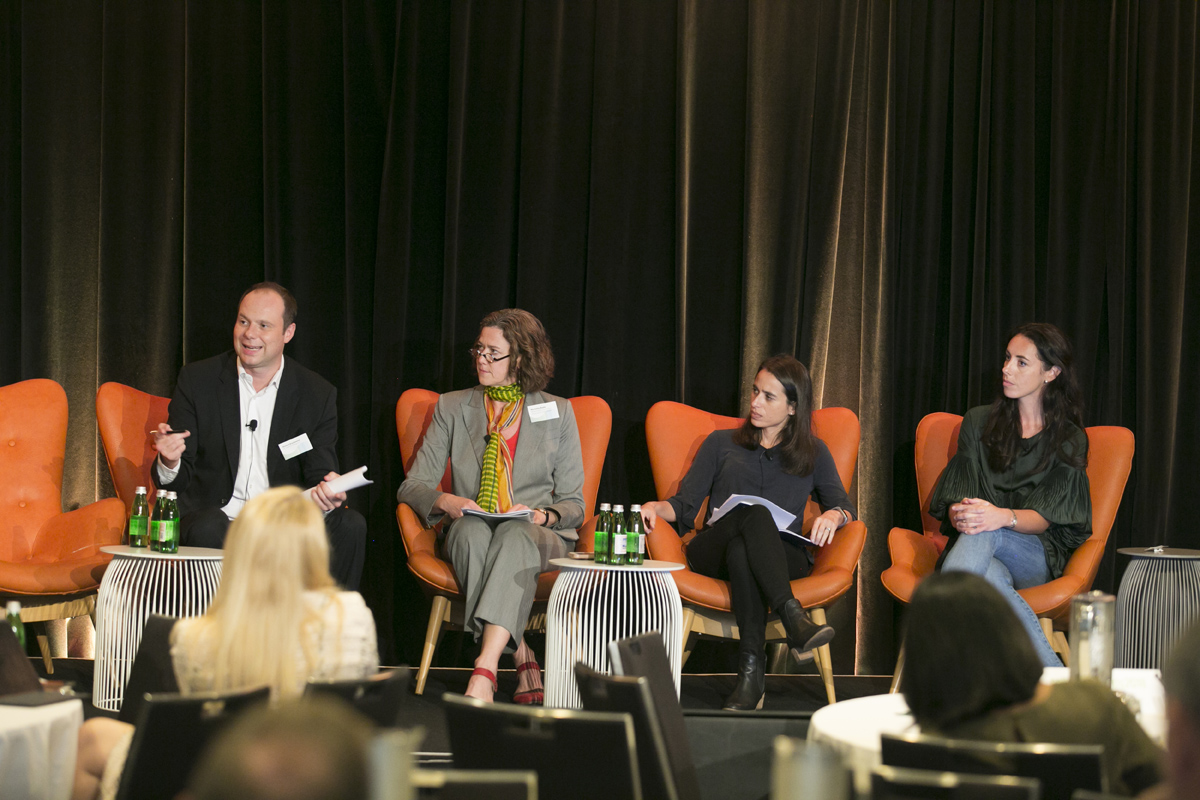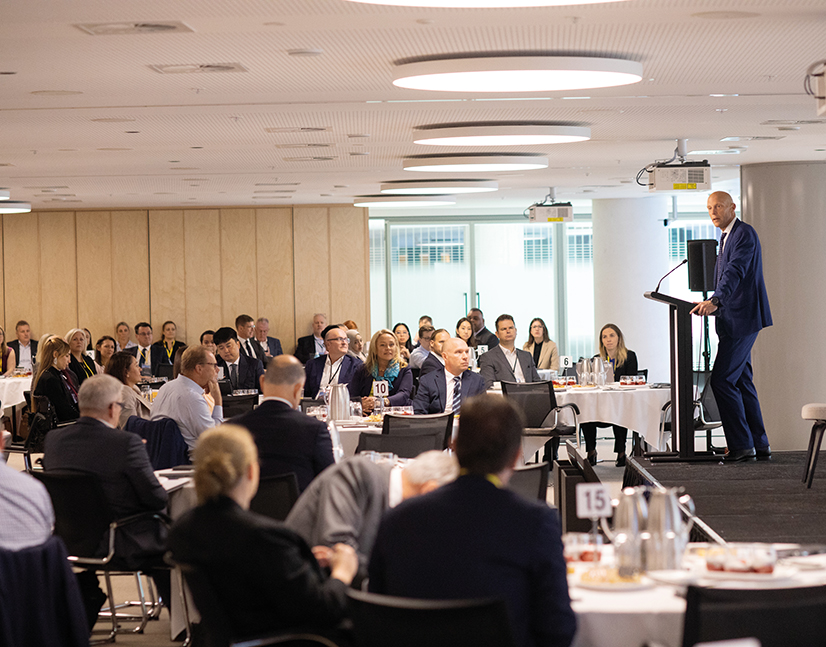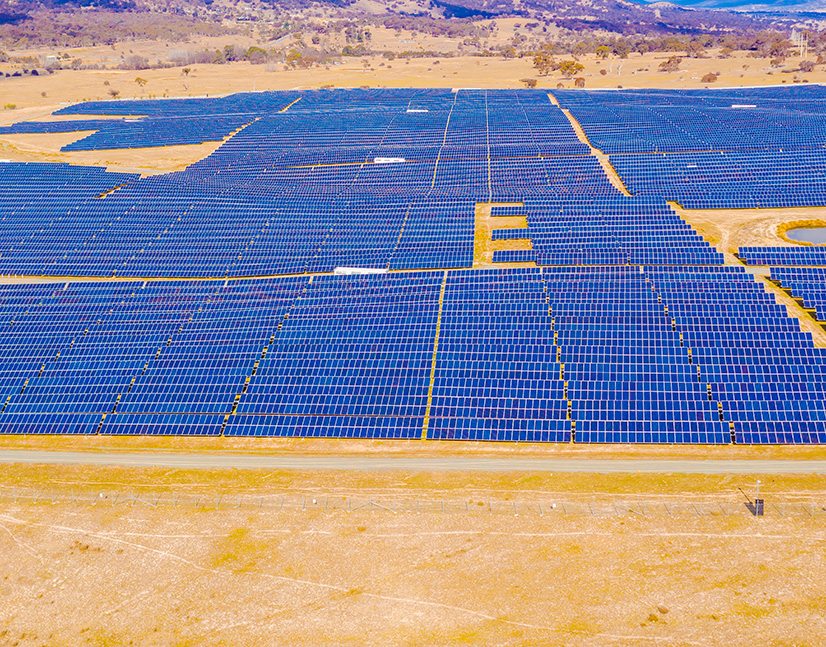
Future shock: future trends in investment
A key topic on the agenda at the KangaNews Sustainable Debt Summit, held in Sydney on 13 March, was how environmental, social and governance (ESG) considerations are reshaping the fundamental nature of investment management. A group of end investors representing disparate corners of the sector discussed ESG as the next frontier in core investment.

PURPOSE AND PROFIT
Boele There is a very big question around whether we fully understand the interests, needs and expectations of end consumers. Our research tells us that purpose now sits alongside profit, with impact and outcomes becoming increasingly important. How do panellists bring the concept of purpose into mainstream investing?
One of the things that large institutional investors are increasingly being mindful of is that every time you invest there are second- and third-order ramifications of the capital-allocation decision. Externalities are both positive and negative and feed back into the long-term returns of investing institutions. Asset owners and managers have a responsibility to be mindful of how capital is allocated because of these externalities.
The point is that this is not just driven by a sense of purpose. It is also because, over the long term, externalities will actually flow back into returns as well.
Another thing asset owners are increasingly talking about is the concept of universal ownership. They are so big in the context of a closed system that they effectively own a slice of the whole ecosystem. If they extract a rent from one part of their portfolio, they will probably pay for it in another part. Global pension fund assets and asset owners generally amounts to about US$130 trillion, which is almost double global GDP.
This means aggregate performance of GDP growth, productivity, earnings growth and all these sorts of things, the externalities if you like, will actually flow back into long-term returns. Hopefully, that US$130 trillion can play a leading role in thinking about the the impact of externalities on the investment decision-making process.
We deal in the world of unlisted funds and managed investments with syndicates of wholesale equity investors who really care about impact. We have seen a lot of take up in that market, while impact investing is still relatively small with institutions. In markets across the world high net-worth individuals are at the forefront of this investment activity. We are effectively packaging up investment opportunities for those investors.
Importantly, our investors do not want to trade off financial returns. We fundamentally believe that assets and businesses that embed impact in their core DNA will outperform over time.
We do this across sustainable property, renewable infrastructure and the venture fund, the Giant Leap Fund, which is the fund I am currently managing. We have a theory of change across all of our asset classes. Property and renewable infrastructure is a bit of a no-brainer, and there is plenty of awareness about how sustainable property attracts increased investor demand because it can reduce costs and attract better tenants, in addition to being the right thing to do.
On the renewables side, which is inherently impactful, since we have been investing in that space we have seen a re-rating of assets as the industry matures. There is a growing opportunity set in this space.
We are now getting up to A$1 billion (US$770.3 million) of assets under management across our entire portfolio.
We raised the venture fund in 2016, predicated on the idea that businesses that deeply embed purpose in what they do are going to outperform over time.
As millennials account for a bigger proportion total disposable income – it has been estimated that in about a decade millennials will be responsible for 75 per cent of disposable income – so it is important to think about how they will choose to consume, how they will choose to invest and who will they want to work for.
We think companies that embed purpose are going to get the lion’s share of those consumer dollars and that talent. Those will be the businesses that outperform over time, and we want to back them.
Boele Jess Ellerm, as cofounder and chief executive of Zuper you have seized the opportunity to create a platform that delivers to millennials. How have you put the consumer at the centre of what you have developed?
Translating the feeling of powerlessness into how people view their finances it is even more profound. The research we did found that eight out of 10 people in our target market didn’t feel confident about making decisions about their finances. There are a lot of other statistics showing that Australia has one of the lowest levels of financial literacy in the developed world.
There is a zeitgeist of government and the big brands not creating the future we want to live in, with a desire to participate more actively in the world and not be powerless. Money is an incredibly important driver in this.
Most people can very easily understand that power and money go together. If you want to have a powerful impact on the future you live in via your money, you naturally end up with superannuation. This is where we came from as founders of the business we wanted to build. We wanted to get people to wake up and take notice of the power they actually have latent within them to do something with their superannuation, and to build out products within that.
The second big driver goes is around people wanting responsible investing and the fact that they are waking up to how much control they have in this respect. For a long time, there was a paternalistic attitude in the financial industry and superannuation, where decisions were being made for consumers. Control and choice was not in the consumer’s realm to have. This framework has been deconstructed in a number of areas, and superannuation and the finance sector is the next wave.
The idea that we can bring choice to customers and members in a meaningful way, and help them navigate and choose where their money is invested, is the biggest challenge and the biggest opportunity we see for Zuper.

Boele What does the Zuper platform do, that others don’t, for the end user?
We then took these themes from the market and deconstructed them to find products off the shelf that we could use to build them out. It wasn’t easy to be as thematically true to label as we wanted, but we got there in the end working very closely with BlackRock.
We use a lot of their megatrends inside our portfolio but the 20 per cent consumers can put all into one, or they can split it into two or three on a ‘big-button’ basis. The rest of the portfolio is growth allocated.
Boele How is this industry going about busting the myth that we have to forego returns to do good?
In addition to producing more product, which we all need to do, we need to collect data on outcomes and publish this data broadly. Fund managers would all agree that you don’t make decisions in the absence of data. As an industry we need to lift our game when it comes to collating data and talking about deals that generate impact and risk-adjusted returns.
There are a lot of studies around the returns of investing with environmental, social and governance (ESG) screens, but we are operating a little bit further down the spectrum at the pointy end of trying to generate positive impact. This is one end of the responsible investment spectrum, where ‘do no harm’ is at the other. Impact investing aims to create measurable, intentional positive impact. We report against the impact that we generate in all our reports, in addition to reporting on the financials.
I think there are also things we can do as consumers and investors in our own right to shift consumer and investment behaviour in order to create the kind of world we want to see.
If we want to contribute to a low-carbon economy, we need to make decisions about shifting where we get our power from. We may need to invest in energy-efficiency technologies. We can shift our diets to plant-based diets so we can lower the amount of emissions coming from livestock.
If we want to improve health and wellbeing, we need to invest in medical innovation and health technologies. If we want to improve equality we can invest in providing equal access to education through ‘edtech’ opportunities.
There is no shortage of opportunities for us to fund in this space. Hopefully the market will grow and we will see more product managers tap into it, using all our money as a resource to create the world we want to live in while still generating financial returns so the process can be sustainable.
I believe Australian Ethical Investment is the fastest growing superannuation fund in Australia, and the reason it is experiencing this growth is because of baby boomers. These investors are at the point of retirement and are thinking about the free education, years of economic growth and opportunity they have enjoyed and therefore that they should do something proactive for the world.
The point is that older investors are also demanding more from their funds than they ever have before, and that is causing meaningful changes in flows.
Boele Are we happy to conclude that investors don’t have to forego financial returns?
“We are getting to the point now where it is no longer a moral decision on behalf of the fund manager to say they don’t want to own companies that are susceptible to, say, animal cruelty. It is about recognising that the externalities of animal cruelty will ultimately be factored back into the earnings of those companies and, if you price that properly, it will in all likelihood be a bad investment.”
CONSUMER SENTIMENT
Boele Our research shows that the majority of consumers want their investments to do no harm. The three top things they wanted to avoid were animal cruelty at 69 per cent, human rights abuses at 62 per cent and pornography at 56 per cent. What is the risk to ignoring such a strong sentiment?
Let’s look at the example of the best-performing sector over the last 100 years: tobacco. That is just a fact – and it is interesting. If you price the risk associated with the future perspective on tobacco it is going to look very different to the past. This is the key – and it is where data is very important.
Investing is a forward-looking game and it feels like societal views are changing very rapidly. I constantly try to test myself on whether I just want to believe that or whether it is true. I’d draw the comparison of Harvey Weinstein: for a long time everyone knew what was happening but it was just ‘the way Hollywood worked’. But from one day to the next it was deemed to be not okay. Suddenly things shifted.
That is where our inflection point is for having a successful business model. One of the things we have learned, coming from a product background, is that you have to remove as much friction as possible from the process. You have to make it really easy because, at the end of the day, companies like Uber might be doing terrible things but millennials will still use their platform because it is convenient.
That may not last forever, but the lesson for us is that the key for social and impact investing is making sure it is frictionless, easy to understand and simple for the masses to enter. This remains to be conquered. We see our responsibility at Zuper as being across both these things. We should understand the impact but we should also be making good financial decisions.
Boele Richard Brandweiner, as an institutional investor, what is the single most powerful tool you can deploy to deal with this consumer sentiment?
But the question is a bit deeper than that. Impact investing as an idea doesn’t really exist for large institutions. This is because there the right sort of scale, institutional quality and liquidity doesn’t exist – and there are not a lot of intermediaries. There is a role for large organisations to collaborate to create impact strategies that work within the governance constraints of large fiduciaries.
For a long time, there was a paternalistic attitude in the financial industry and superannuation, where decisions were being made for consumers. Control and choice was not in the consumer’s realm to have. This framework has been deconstructed in a number of areas, and superannuation and the finance sector is the next wave.
Boele Does impact investment point in some way to a feeling that such values are not reflected in the democratic process?
I see a future where we can sit down with companies and say: “We would love to invest in you but you don’t stack up on these points, what are you going to do about it?” This makes me very excited about the difference we could make.
We have a lot of ideas about crowdsourcing potential investment opportunities. One of the big drivers that came out of our research was that people really want to be invested in agriculture but it isn’t easy for a fund like Zuper to build products, especially off the shelf.
Another thing is the role of artificial intelligence in capturing opportunities around returns and better investments. This is also something we can tap into. It is about using new technology to find outsized returns that in the past would have required lots of people to assess.
At the same time, the Australian superannuation system is worth around A$2.3 trillion, so it is much bigger than GDP. If you take all of the philanthropic foundations in Australia they add up to about A$8 billion. The philanthropic sector which is minute compared to the power of our superannuation system.
The last 20 years has seen a significant rise in the amount of money that is controlled by a relatively small number of asset owners globally, whether they are sovereign wealth funds or the large pension funds. The power these investors, fiduciaries and trustees have going forward is absolutely enormous and different to what the situation was before.
As a society we need a social license to operate, and this means we need to be investing in ways that are mindful of our future.
Boele What do the panellists believe is the biggest thing to look out for in investment trends?
We need to start democratising some of these investment opportunities for retail and institutional investors as well as high net-worth investors. That is where we as an organisation are focusing on enhancing our range of product, democratising access to products and making them easily accessible.
Hopefully we will reach a point where the intentionality of the way we approach investments is not unique. In other words, where everyone brings the externalities and implications of how they invest into their decision-making.
But risk was always there – we just didn’t think about it. The second- and third-order ramifications of an investment, the impact and externalities, is the third axis and it has also always been there. We don’t think about it enough because it is hard to measure. What we hope is that the next generation will find it just as ludicrous to ignore the impact axis as we find ignoring the risk axis.

WOMEN IN CAPITAL MARKETS Yearbook 2023
KangaNews's annual yearbook amplifying female voices in the Australian capital market.

















